INSHORE FISHES OF HOWLAND ISLAND, BAKER ISLAND, JARVIS ISLAND, PALMYRA ATOLL, AND KINGMAN REEF
BY
BRUCE C. MUNDY,RICHARD WASS,EDWARD DEMARTINI, BRIAN GREENE,BRIAN ZGLICZYNSKI,ROBERT E. SCHROEDER,
AND CRAIG MUSBERGER
ISSUED BY
NATIONAL MUSEUM OF NATURAL HISTORY SMITHSONIAN INSTITUTION
WASHINGTON, D.C., U.S.A.
DECEMBER 2010
the Pacific Ocean.
________________________________________
1 National Oceanic and Atmospheric Administration, National Marine Fisheries Service, Pacific Islands Fisheries Science Center, Fishery Biology and Stock Assessment Division, 2570 Dole Street, Honolulu, Hawai`i 96822
2 U.S. Fish and Wildlife Service, Big Island NWR Complex, 32 Kinoole St., Suite 101, Hilo, Hawai`i 96720
3 National Oceanic and Atmospheric Administration, National Marine Fisheries Service, Pacific Islands Fisheries Science Center, Coral Reef Ecosytem Division, 2570 Dole Street, Honolulu, Hawai`i 96822
4 Present address: Department of Zoology, University of Hawai`i at Manoa, Honolulu, Hawai`i 96822
5 Present address: National Oceanic and Atmospheric Administration, National Marine Fisheries Service, Pacific Islands Regional Office, Habitat Conservation Division, 1601 Kapiolani Boulevard, Suite 1110, Honolulu, Hawai`i 96814
BY
BRUCE C. MUNDY,1 RICHARD WASS,2 EDWARD DEMARTINI,1 BRIAN GREENE,3,4 BRIAN ZGLICZYNSKI,3 ROBERT E. SCHROEDER,3,5
AND CRAIG MUSBERGER3,4
ABSTRACT
A list is given of shore fishes known from Howland and Baker Islands, outliers of the Phoenix Islands group, and Jarvis Island, Palmyra Atoll, and Kingman Reef in the Line Islands group. The list was compiled from literature sources, museum collection databases, and surveys conducted in 2000–2008 by the NOAA Pacific Islands Fisheries Science Center’s Coral Reef Ecosystem Division (CRED). A total of 506 shore-fish species and 27 epipelagic species were recorded from the five islands. Of the shore-fish species, 41 (8.1%) were first noted in our CRED surveys. Numbers for the individual islands are: Howland Island—328 species of which 166 (50.8%) are first records from CRED sampling; Baker Island—268 species with 188 (70.1%) as new CRED records;
Jarvis Island—274 species with 176 (64.2%) as new CRED records; Palmyra Atoll—395 species with 113 (28.6%) as new CRED records; and Kingman Reef—270 species with 212 (78.5%) as new CRED records. Fifteen additional species whose identifications are in need of verification were reported in our surveys or previous efforts. An additional 16 are considered suspect identifications of species that probably do not occur at the Line or Phoenix Islands. Differences in the species composition of the five islands are discussed in the context of habitat diversity, historic sampling effort, and regional oceanography.
The evolution of shore-fish species found at these central Pacific islands is reviewed in the context of phylogeographic information, geology of Pacific islands, and regional oceanography. It is argued that oceanography and dispersal have played a larger role than geologic adjacencies in the evolution of central Pacific oceanic island fishes. Knowledge of the fish fauna of the central equatorial Pacific remains incomplete, in part, because of limited sampling of small, nocturnal, or otherwise cryptic species. These five islands are
Manuscript received 3 March 2010; revised 23 July 2010.
else in the country. The isolated islands of the central Pacific remain one of the most poorly understood regions on earth for knowledge of biodiversity.
INTRODUCTION
Howland Island, Baker Island, Jarvis Island, Palmyra Atoll, and Kingman Reef are United States possessions in the central Pacific Ocean (Fig. 1, Table 1). Howland and Baker Islands are outliers of the Phoenix Islands, while Jarvis Island, Palmyra Atoll, and Kingman Reef are part of the Line Islands group. They were designated as part of the Pacific Remote Islands Marine National Monument on January 6, 2009, under the authority of the Antiquities Act of 1906. The five islands are managed by the U.S. Fish and Wildlife Service (USFWS), with Palmyra Atoll managed in partnership with the Nature Conservancy. These islands are tiny relative to the Hawaiian Islands, American Samoa, Guam, or the Commonwealth of the Northern Marianas that, together with Wake Island and Johnston Atoll, comprise the other U.S. Pacific islands. Maragos et al. (2008) and Miller, Maragos et al., (2008) summarized their geography, history, geology, climate, oceanography, and biology.
Little information exists on the marine biota of the U.S. equatorial Pacific islands compared to more populated Pacific locations. Until recently, this region of the Pacific (10°N–10°S by 145°W–180°) was one of the most poorly investigated portions of the world’s oceans outside of the polar regions. Beginning in 2000, ecological surveys of the shallow coral reef habitats of the U.S. equatorial Pacific islands were conducted by the Coral Reef Ecosystem Division (CRED) of the National Oceanographic and Atmospheric Administration’s (NOAA) National Marine Fisheries Service (NMFS or NOAA Fisheries), Pacific Islands Fisheries Science Center (PIFSC). In this paper, we report the species composition of the fishes observed with visual inventories during the first six CRED survey cruises to the five islands on the NOAA Ship Townsend Cromwell (TC) in 2000, 2001, and 2002, on the NOAA Ship Oscar Elton Sette in 2004, and the NOAA Ship Hi`ialakai in 2006 and 2008. We also review previous surveys of the fishes of these islands (excluding deep-sea species) from published sources, unpublished reports of the U.S. Fish and Wildlife Service, larval fish surveys conducted from the Townsend Cromwell during 1990 and 1992, and online databases of specimens from these islands in several U.S. museum ichthyology collections.
PREVIOUS ICHTHYOLOGICAL SURVEYS
The earliest fish collection at these islands of which we are aware was at Baker Island in 1864 by Captain Joseph Hammond, represented by two specimens of Istiblennius in the collection of the Academy of Natural Sciences (ANSP) of Philadelphia, ten in the collection of the Museum of Comparative Zoology (MCZ) at Harvard University, and two at the Bernice P. Bishop Museum (BPBM) at Honolulu. The
first fish species described from these islands was Serranus howlandi by Günther in 1873 [now Epinephelus howlandi (Günther, 1873)], based on a specimen collected by Andrew Garrett and held in the collection of the Natural History Museum (earlier known as the British Museum, Natural History).
Streets (1877) reported on a small collection of fishes from the 1873-1874 expedition of the U.S. Ship Portsmouth to “the Fanning Islands” [= Line Islands], including Palmyra Atoll. The collection localities for most species in Streets (1877) were reported only as “Fanning Islands” or “Fanning Group,” making it impossible for us to determine which were collected at Palmyra vs. other islands of the archipelago.
Some of Streets’ specimens were deposited at the National Museum of Natural History, Smithsonian Institution (USNM).
Howland
Island Baker Island Jarvis Island Palmyra
Atoll Kingman
Reef
Position 0°48'04'’N, 176°38'4'’W
0°11'40'N, 176°28'43'’
W 0°23'25'S,
160°0'50'’W 5°52'34"N, 162°4'32"W
40 mi. north of Palmyra, ca. 6°24′N, 162°22′W Emergent
island area
(hectares) 184.1 163.9 439.5 275.2 1.2
Year of
refuge status 1974 1974 1974 2001 2001
Island type Island Island Island Atoll, highly modified
Tilted Atoll, mostly submerged Marine
refuge area
(km2) 131.73 128.43 151.83 2086.69 1958.99
Maximum height above
sea level (m) 3–6 5–8 6–7 2–3 1–2, varying
among years Mean rainfall
(mm/yr) < 500 < 500 < 500 > 5080 > 5080 Coastline
(km) 6.4 4.8 8.0 14.5 < 0.1 (3.0 for
reef shoals) Table 1. Characteristics of Howland Island, Baker Island, Jarvis Island, Palmyra Atoll,
and Kingman Reef (from Grigg et al., 1988; Defense Mapping Agency, 1988; Maragos, 1997; Central Intelligence Agency, 2001; Spalding et al., 2001; Maragos et al., 2008).
of 1922 (Edmondson, 1923). The 1913 expedition included H. E. Cooper, then the island’s owner, J. F. Rock, a botanist from the College of Hawai`i (now the University of Hawai`i), and C. M. Cooke, Jr., a malacologist from the BPBM. The 1922 expedition included L. A. Thurston and D. Thaanum of Honolulu. Fishes collected by Cooke, Thurston, and Thaanum were deposited in the BPBM collection, where they were initially analyzed by the visiting ichthyologist H. W. Fowler in the 1920s. Fowler was the ichthyology curator at ANSP and he transferred many duplicate fish specimens from BPBM collections to ANSP. He reported many of the fishes from the Bishop Museum in his reviews of the fishes of Oceania (Fowler, 1928, 1931, 1934, 1949).
In 1924, scientists from the Whippoorwill Expedition, part of the larger Tanager Expedition to several Pacific islands, collected fishes at Jarvis, Howland, and Baker Island, and at Palmyra Atoll (as well as other Line Islands). These are also now divided between the BPBM and ANSP collections. Fowler (1927) described the Whippoorwill Expedition fishes and later included information on the fishes from the equatorial Pacific islands in his 1928-1949 reviews.
The 1933 Templeton Crocker Expedition to Polynesia and Melanesia collected a few fishes at Palmyra Atoll. These are archived at the California Academy of Sciences (CAS) ichthyology collection.
Specimens collected at some of these islands by smaller expeditions in the early 20th Century are held at the BPBM. These were incorporated in Fowler’s 1928-1949 reviews. The smaller expeditions include those designated in BPBM collection records as the 1935 “Dr. Dana Coman Expedition” and collections from the U.S. Coast Guard vessel Itasca beginning in 1936. Dr. E. H. Bryan of BPBM may have participated in the Coman Expedition, as indicated by the collection data for BPBM 10133 (a Myrichthys colubrinus). The Itasca specimens were products of an astonishing, but until recently little known, effort by the United States to claim Howland, Baker, and Jarvis Islands by “colonizing” them with Hawaiian high-school students (Burlingame, 2002). The tasks given to these students included the collection of natural history specimens. The students were not told what their destinations were and lived on these bleak islands for 6 months or more at a time. Of ca. 135 students participating in this effort, 3 died;
1 from appendicitis-induced peritonitis and 2 during a shelling of Howland Island by the Japanese Navy on December, 1941 (Burlingame, 2002; Tengan, 2008). The fish specimens that they collected for BPBM are part of their legacy.
In 1937, the George Vanderbilt South Pacific Expedition, on the auxiliary schooner Cressida, collected 56 fish specimens of 5 species at Jarvis Island and 33
specimens of 21 species at Palmyra Atoll. These were also reported by Fowler (1938) and the specimens were placed in the ANSP collection.
There are several specimens in the BPBM collection that were collected during February 1948 and June 1949, but no collectors or vessels are named in the collection data for these.
In August 1951, Earl S. Herald, Robert R Rofen (Harry), and others collected fishes at Palmyra Atoll during a second George Vanderbilt Foundation (GVF) effort, its Equatorial Expedition, from the vessel Pioneer. Specimens from that expedition were originally placed in the Stanford University (SU) ichthyology collection and are now archived at CAS, as are other fish specimens from Stanford (Brittan, 1997).
Palmyra Atoll, and Jarvis Island during cruises from the USFWS Pacific Oceanic Fishery Investigations Laboratory (POFI, now the PIFSC) in 1950-1953. Large species taken in these surveys were recorded by Halstead and Schall (1958). Some of these remain in the ANSP and USNM collections. An unpublished report by Halstead (1951) from the preliminary sampling for that study contains one record of a species from Kingman Reef (Lutjanus fulvus) omitted from Halstead and Schall’s (1958) published paper.
The University of Hawai`i (UH) sent expeditions to Palmyra Atoll on several occasions in the 1950s and early 1960s. Specimens from 1953, collected by J. E. King and others, are listed in the BPBM collection as having been transferred from the UH fish collection. In late 1959 and early 1960, fishes were collected by W. Gosline, then the UH professor of ichthyology, and his students, D. Strasburg, A. H. Banner, and P. Helfrich.
The BPBM also has collections, transferred from the UH fish collection, from Palmyra in1962 by Helfrich, P. S. Miles, L. G. Eldredge, and others.
POFI vessels made collections at and near these islands on several occasions during 1950–1966, including cruises by the R/V J. M. Manning in 1954, the R/V H. M.
Smith in 1956, and the R/V C. H. Gilbert in 1960 and 1966. These fishes are in the BPBM collection, but most are oceanic species and are not included in this report. A few of the fishes captured by trolling and longlining by POFI, but not retained, were reported by Murphy and Shomura (1953, 1955) and Iversen and Yoshida (1956, 1957).
In 1963 and 1964, the Smithsonian Institution collected fishes at the islands, including samples of small, cryptic species that have otherwise not been surveyed at these locations. Most of these are now in the USNM. The Smithsonian’s Pacific island surveys, primarily terrestrial in emphasis, were known by several names. Initially, the surveys were called only the Southern Island Cruises but were soon formally named the Pacific Ocean Ornithological Project to better reflect their primary emphasis (Clapp, 2002).
Shortly thereafter, however, the program was renamed the Pacific Ocean Biological Survey Project (POBSP) by someone who was acronym attentive and perhaps who had less humor. The origin and history of this program are controversial (MacLeod, 2001), but those controversies do not affect the value of the resultant ichthyological surveys.
Fish specimens from this effort are listed in the Smithsonian’s database under the more recent and euphonious acronym for the Smithsonian Institution Pacific Ocean Biological Survey program (SIPOBS). No summary report was published describing the SIPOBS fishes.
In 1968 and1977, J. E. Randall, H. A. Randall, J. McVey, W. Hashimoto, R.
McNair, G. S. Haywood, and G. Friedholm, scientists from the UH and BPBM aboard the research vessel Westward, collected fishes at Palmyra Atoll. These were deposited at BPBM.
In 1986, D. K. McDermond and R. C. Wass (USFWS) compiled a list of reef fishes from visual observations during seven snorkeling surveys at Howland Island and two at Baker Island (McDermond and Wass, 1986).
In 1990 and 1992, the NOAA Fisheries scientists aboard the Townsend Cromwell surveyed larval fish distributions in the vicinity of Palmyra Atoll, collected samples of shallow-dwelling midwater fishes with plankton nets and midwater trawls, and made a few in-situ observations of adult inshore fishes by snorkeling surveys. Specimens from those cruises, TC9007 and TC9201, remain among the uncataloged larval fish collection
table 2).
A few other small collections from the five islands are not reviewed here, although several specimens from them were included in our inventory.
METHODS
The surveys at the five islands that initiated our study were at visual rapid ecological assessment stations in March–April 2000, January-February 2001, and January-February 2002. Two or three scuba divers would descend at a location and survey diurnally active, non-cryptic, reef-associated, shallow-dwelling fishes between 3 and 20 m for ca. 50–60 minutes. Much of the time was occupied with counting the fishes seen along measured transects. Two observers conducted the fish survey stations in 2000 and 2002. A third observer participated in 2001, with the primary task of roving the area around transects and identifying all fish species seen. Additional records were obtained from towed-diver transects, rapid ecological assessment surveys, and stationary point count stations. The survey methods are described in more detail by Brainard et al. (2005).
Most of our stations at Howland, Baker, and Jarvis Islands were at the leeward slopes of their western sides (Figs. 2–4). Easterly winds dominate weather at Howland, Baker, and Jarvis Islands. The swells are likewise usually from the east or northeast, making the western reef slopes the most protected areas. The abrupt shoaling of the bottom at these islands causes large surf to result at the shelf breaks, making small boat operations hazardous. Stations at Palmyra Atoll were more uniformly distributed around that atoll (Fig. 5), although surveys at the eastern end were limited by the stronger winds and swells there. Our stations at Kingman were concentrated in the eastern half of the reef, primarily in the lagoon and along the protected inner edges of the reef (Fig. 6).
Currents at Kingman Reef are often very strong along the outer north and south edges of the atoll, and they intensify from the east to the west in the lagoon.
Station locations were obtained with Global Positioning System (GPS) units on the dive skiffs. The fish team did not record GPS locations for their stations during the first cruise, but instead relied on positions recorded by the coral survey biologist (J.
Maragos, USFWS). This provided location data for most stations, but in a few instances the fish team surveyed stations not surveyed by the coral biologist, leaving some stations without position data. In addition, the quality of the GPS units and satellite position data was less during 2000 than in 2001, and most accurate in 2002. In most instances, text descriptions of the station locations written during our sampling enabled us to resolve these problems.
Effort varied at the different islands in different years (Table 2a, b). Howland and Baker Islands had about the same level of effort, while Jarvis Island had slightly more.
Kingman Reef and Palmyra Atoll had more effort expended because of their sizes and, for Palmyra, diversity of habitats.
Our identifications are based almost entirely on visual criteria. Almost no specimens were collected, and few photographs were taken to confirm identifications.
Our identifications cannot be definitive without voucher specimens or photographs.
Figure 2. Howland Island as shown on NOAA navigational charts prior to 2003, with the locations of the NOAA Fisheries fish observation stations in 2000–2002.
Figure 3. Outline of Baker Island as shown on NOAA navigational charts prior to 2003, with positions of NOAA fish transect stations.
Figure 4. Outline of Jarvis Island as shown on NOAA navigational charts prior to 2003 with station locations for NOAA fish surveys.
Figure 5. Outline, position, and bathymetry of Palmyra Atoll as shown in NOAA navigational charts prior to 2003.
Nevertheless, we are confident that most of the identifications of the larger, distinctively colored species are correct as based on information in the taxonomic works in our literature cited. Our identifications of the smaller, visually less distinctive species need verification. For this reason we made the effort to incorporate into this report records from taxonomic publications and from collections of the four major museums (CAS, ANSP, BPBM, and USNM) that archive specimens from the equatorial Pacific islands.
No effort was made to verify the identifications of those specimens by examination, but by listing them we hope to give interested researchers information that will prompt future efforts to verify the identifications of fishes from these islands. Museum collection numbers for the museum records listed below are available upon request from the first author. The information from the USNM database was provided with the permission of the National Museum of Natural History, Smithsonian Institution, 10th and Constitution Ave. N.W., Washington, DC 20560-0193. (http://www.nmnh.si.edu/); access to the USNM data is available at http://vertebrates.si.edu/fishes/fishes_collections.html. The information from the Academy of Natural Sciences of Philadelphia Information was provided with the permission of The Academy of Natural Sciences, Philadelphia, PA.
The order in which families are listed is that of J. Nelson (2006), except that we follow Smith and Craig (2007) in recognizing the Epinephelidae as a family distinct from the Serranidae. A few changes to the taxonomy of shore-fish species in the region are worth noting, to explain why some names used herein differ from those in common usage prior to 2010. Craig and Hastings (2007) placed Aethaloperca and Gracila as junior synonyms of Cephalopholis, and we follow their conclusion. Marshall et al. (2009) demonstrated that there are two species of Manta in the region. We identified the mantas in our surveys as M. birostris (Walbaum), following the practice prior to Marshall et al. (2009) of considering the genus to contain only that species. Marshall et al. (2009)
Figure 6. Outline and position of Kingman Reef as shown on NOAA navigational charts prior to 2003, with locations of NOAA Fisheries fish transect stations.
Island2000 # Stations (2 observers)
2001 # Stations
(3 obser
vers)
2002 # Stations
(2 obser
vers)
2004 # Stations (3 observers)
2006 # Stations (3 observers)
2008 # Stations (4 observers)
Total number of stations
Total number of observers X stations Howland Island4666 6 1240122 Baker Island5656 8 7 37108 Jarvis Island5456 9 2049157 Palmyra Atoll65 1110132873230 Kingman Reef6999 162372215 Total263036375290271832
Table 2a. CRED sampling effort at each island in 2000-2008.
Howland: 12 expeditions, 11 reef sampling
Günther (1873-1875) – Andrew Garrett specimen Whippoorwill expedition – 1924
Dr. Dana Coman Expedition – 1935 Itasca – 1936
POFI H. M. Smith cruise - 1950 SIPOBS – 1963
SIPOBS - 1964 SIPOBS - 1966
McDermond and Wass (1986) TC0001
TC0101 TC0201 OES0401 HI0601 HI0801
Baker: 11 expeditions, 11 reef sampling Capt. Joseph Hammond—1864 Whippoorwill expedition—1924 Dr. Dana Coman Expedition—1935 Itasca—1936
SIPOBS—963 SIPOBS—1964 SIPOBS—1966
McDermond and Wass (1986) TC0001
TC0101 TC0201 OES0401 HI0601 HI0801
Jarvis: 16 expeditions, 12 reef sampling Whippoorwill expedition—1924 Dr. Dana Coman Expedition—1935 Itasca—1936
POFI—1951
Unidentified expedition—1952 POFI—1953
Halstead and Bunker (1954) Iversen and Yoshida (1957) Halstead and Schall (1958) SIPOBS—1963
Table 2b. Expeditions to each island
SIPOBS—1964 SIPOBS—1966
Unidentified Expedition (SIPOBS?) —1969 TC0001
TC0101 TC0201 OES0404 HI0604 HI08-03
Palmyra: 36 expeditions, 30 reef sampling Streets (1877)
Cooper, Rock, and Cooke—1913 (Edmondson, 1923) Cooke—1916
Thurston and Thaanum—1922 Whippoorwill Expedition—1924 Templeton-Crocker Expedition—1933
Dr. Dana Coman Expedition—1935 (same as 1935 Bryan expedition?) George Vanderbildt Expedtion, Cressida—1937
Vasconcellos—1940 W. Chapman—1944
Unidentified expedition (M. Schaefer) —1948 Peterson/Calistar—1949
“Unidentified expedition” = POFI, H. M. Smith cruise—1950 George Vanderbilt Foundation, Herald and Rofen et al. —1951 POFI—1951
J. King (POFI), H. M. Smith Cruise—1953 (Murphy and Shomura, 1953?) Unidentified—1955 (Shomura and Murphy, 1955)
Iversen and Yoshida (1956?) Iversen and Yoshida (1957) Halstead and Schall (1958)
Gosline, Strasburg, Banner, Helfrich, Strasburg—1959–1960 Helfrich, Miles, Eldredge et al. —1962
SIPOBS—1963 SIPOBS—1964 SIPOBS—1966
BCF Vessel Gilbert—1966
Westward (Randall, Randall, McVey, Hashimoto, McNair, Haywood, and Friedholm)
— 1968
Westward (Randall, Randall, McVey, Hashimoto, McNair, Haywood, and Friedholm)
—1977
McDermond and Wass (1986) TC9007
TC9201
demonstrated that the smaller species occurring more frequently close to shore in the Indo-Pacific is M. alfredi (Krefft), but we now identify the mantas recorded herein only as Manta species in the absence of data to confirm the species to which they belonged.
White et al. (2010) demonstrated that the Indo-Pacific spotted eagle ray previously identified as Aetobatus narinari (Euphrasen) is a distinct species taking the
name A. ocellatus (Kuhl), and we follow their conclusion herein. We also use the name Acanthurus nigros Günther for the Indo-Pacific population of the surgeonfish usually called A. nigroris Valenciennes, following advice that A. nigroris should be recognized as an endemic Hawaiian Islands species (Randall et al., in press).
A number of oceanic, epipelagic species that have been recorded from the vicinity of the islands are listed separately. These include literature records and species, seen by us, swimming just offshore of our survey stations. Some of the latter moved toward us briefly, enabling us to obtain good identifications. Others were seen only at a distance, making their identifications tentative. The division between the inshore fishes and the oceanic epipelagic species is arbitrary, but generally follows conventions in commonly used guides to tropical Pacific fishes (e. g., Myers, 1999; Randall, 2005). A good example showing how difficult it is to establish a precise distinction between inshore and oceanic
Nelson and Seibel—2001 TC0001
TC0101 TC0201
Handler and James—2006 OES0404
HI0604 HI0803
Kingman: 15 expeditions, 8 reef sampling Commonwealth cruise—1950 POFI—1951
POFI—1953 Halstead (1951)
Murphy and Shomura (1953)
Unidentified expedition—1955 (same as below?) BCF vessel J. R. Manning—1956
Iversen and Yoshida (1957) Halstead and Schall (1958) Gilbert cruise (POFI)—1960 Westward—1968 or 1977 McDermond and Wass (1986) TC0001
TC0101 TC0201 OES0404 HI0604 HI0803
not found over reefs; however, these fishes were found swimming over the shallow top of a patch reef inside of the Kingman Reef lagoon. We, therefore, classify some otherwise oceanic species as inshore if they were found swimming directly above reefs, as opposed to swimming or having been captured in waters offshore of reefs within our survey depths. Thus, we list Manta species and Ablennes hians among the inshore fishes, although they are certainly as pelagic in habitat as are species such as Euthynnus affinis and Psenes cyanophrys that we list as oceanic epipelagics.
In our results, new records from our surveys at the five individual islands are those for which only “CRED”, reference 1 (Brainard et al., 2005), or reference 2 (Miller et al., 2008) are given. References 1 and 2 summarize results of CRED surveys. Species that are newly recorded in our surveys from all of the Line or Phoenix Islands are listed in Table 3. The tabulations of numbers and percentages of inshore species at each island and island group used taxa identified to species, or to genera when no species within a genus was identified from an island at which the genus was recorded.
The relationship of shore-fish numbers at the five islands to those at other Pacific islands and archipelagos was analyzed with principals of island biogeography theory.
The four parameters investigated were the distance along the Indo-Pacific diversity gradient from the Indo-Australian Archipelago center of diversity (IAA), isolation from other islands, island area, and island age (e. g., MacArthur and Wilson, 1963;
Connolly et al., 2003; Bellwood et al., 2005; Whittaker et al., 2008). Fish habitat area is a more meaningful measure of effective biogeographic area than simple island size (R. Brainard, PIFSC, pers. comm.), but we could not use data on fish habitat area in our analysis because those data were not available for many of the Pacific islands or island groups at which shore-fish species have been inventoried. Regression analyses were done with Sigmaplot©. Linear or exponential functions were fitted to the data depending upon the theoretical functions proposed for the relationships (MacArthur and Wilson, 1963;
Connolly et al., 2003; Whittaker et al., 2008) and the visually apparent relationships of species numbers vs. the four parameters. For analysis of distance from the IAA, the center of Sulawesi was arbitrarily chosen as the location of the IAA center, as Sulawesi is approximately in the middle of the triangle defined by Indonesia, the Philippines, and New Guinea. The relationship between species number and distance from the center of the IAA was an exponential decay function. Our first exploration of the best fit to the data produced a curve with several inflection points and an unrealistic negative species number for the farthest distance from the IAA. We, therefore, rejected this and constrained the regression to one with a single inflection point, for parsimony, and with its origin at the observed values for Easter Island, the island with the smallest species number and greatest distance from the IAA. Unconstrained linear functions gave the best fit to the three other relationships. The relationship of species number to island age was analyzed with the ATT2 model of Whittaker et al. (2008) with the function: log, (island area) + island age + (island age)2. Indonesia, the Philippines, New Guinea, and New Caledonia were included in the analyses of distance, isolation, and area to provide data on species numbers in the center of biodiversity, but were excluded from the analysis of island age because they are groups of continental islands of composite ages, with
Table 3. New records from our surveys of fish species from the U.S. Line and Phoenix Islands. (Note that the new records for the Phoenix Islands below are based on
occurrences at Howland and Baker Islands. Those islands are most similar to the Line Islands in species composition, not the main Phoenix Islands. Therefore, records of fish species from Howland and Baker may not indicate that those species can be expected in the main Phoenix Islands.)
Nebrius ferrugineus—new record for the Line Islands.
Carcharhinus albimarginatus—new record for the Line Islands.
Sphyrna lewini—new record for the Phoenix Islands.
Sphyrna mokarran—new records for the Line and Phoenix Islands.
Taeniura meyeni—new record for the Phoenix Islands.
Aetobatus ocellatus—new record for the Phoenix Islands.
Gymnomuraena zebra—new record for the Phoenix Islands.
Gymnothorax breedeni—new record for the Phoenix Islands.
Unidentified deepwater Conger species—new record for the Phoenix Islands.
Neoniphon opercularis—new record for the Phoenix Islands.
Sargocentron diadema—new record for the Phoenix Islands.
Cephalopholis rogaa—new records for the Line and Phoenix Islands.
Cephalopholis aurantia—new record for the Phoenix Islands.
Epinephelus howlandi—new record for the Line Islands, but identification needs to be confirmed.
Epinephelus lanceolatus—new record for the Line Islands.
Epinephelus retouti—new record for the Phoenix Islands.
Epinephelus spilotoceps—new record for the Phoenix Islands.
Pseudanthias bicolor—new record for the Phoenix Islands.
Pseudanthias cooperi—new record for the Phoenix Islands.
Pseudochromidae species—new family record from the Line Islands based on collection of larvae, genus and species undetermined.
Heteropriacanthus cruentatus—new record for the Phoenix Islands.
Ostorhinchus apogonides—new records for the Line and Phoenix Islands.
Atule mate—new record for the Line Islands.
Caranx ignobilis—new record for the Phoenix Islands.
Mulloidichthys mimicus—new record for the Phoenix Islands.
Parupeneus cyclostomus—new record for the Phoenix Islands.
Sectator ocyurus—new record for the Phoenix Islands.
Paracirrhites arcatus—new record for the Phoenix Islands.
Paracirrhites xanthus—new record for the Line Islands.
Abudefduf vaigiensis—new record for the Phoenix Islands.
Chromis agilis—new records for the Line and Phoenix Islands.
Chromis caudalis—new record for the Phoenix Islands Chromis xanthura—new record for the Phoenix Islands.
Plectroglypidodon phoenixensis—new record for the Line Islands.
Stegastes fasciolatus—new records for the Line and Phoenix Islands.
Anampses melanurus—new record for the Line Islands.
Anampses meleagrides—new record for the Phoenix Islands.
Bodianus axillaris—new record for the Phoenix Islands.
accreted terrains, to which Whittaker et al.’s (2008) model was not intended to apply.
Although the four regressions were not intended to be a rigorous statistical analysis in a model of island species richness, r2 values were calculated as an indication of the relative strengths of the relationships of the relative contributions of distance from the IAA, island isolation, island area, and island age to the variability of species numbers at Pacific islands and archipelagos.
As a heuristic tool for investigating the biogeographic relationships of reef fishes at the U.S. equatorial Pacific islands, a similarity analysis of species presence/
Cheilinus oxycephalus—new records for the Line and Phoenix Islands.
Cheilinus trilobatus—new record for the Line Islands.
Halichoeres melasmopomus—new record for the Phoenix Islands.
Halichoeres claudia—new record for the Phoenix Islands.
Hemigymnus fasciatus—new record for the Phoenix Islands.
Labrichthys unilineatus—new records for the Line and Phoenix Islands, but identifications need verification.
Labroides bicolor—new record from the Phoenix Islands.
Labroides rubrolabiatus—new record from the Phoenix Islands.
Labropsis xanthonota—new record from the Line and Phoenix Islands.
Pseudocheilinus evanidus—new records from the Line and Phoenix Islands.
Pseudocheilinus octotaenia—new record for the Phoenix Islands.
Pseudocoris heteroptera—new records for the Phoenix Islands.
Thalassoma lutescens—new record for the Phoenix Islands.
Thalassoma trilobatum—new record for the Line Islands.
Scarus trilobatus—new record for the Phoenix Islands.
Exallias brevis—new record for the Line Islands.
Amblyeleotis fasciata—new record for the Line Islands.
Valenciennea strigata—new record for the Phoenix Islands.
Ptereleotris evides—new record for the Phoenix Islands.
Ptereleotris zebra—new record for the Phoenix Islands.
Zanclus cornuta—new record for the Phoenix Islands.
Acanthurus maculiceps—new record for the Phoenix Islands.
Acanthurus mata—new records for the Line and Phoenix Islands.
Acanthurus pyroferus—new record for the Phoenix Islands.
Acanthurus thompsoni—new records for the Line and Phoenix Islands.
Ctenochaetus hawaiiensis—new record for the Phoenix Islands.
Naso brevirostris—new record from the Phoenix Islands.
Naso caesius—new record from the Phoenix Islands.
Naso hexacanthus—new record from the Phoenix Islands.
Naso unicornis—new records for the Line and Phoenix Islands.
Naso vlamingii—new record for the Phoenix Islands.
Paracanthurus hepatus—new record for the Phoenix Islands.
Zebrasoma rostratum—new record for the Phoenix Islands.
Gymnosarda unicolor—new record for the Line Islands.
Ostracion meleagris—new record for the Phoenix Islands.
Canthigaster amboinensis—new record for the Phoenix Islands.
Canthigaster janthinoptera—new record for the Phoenix Islands.
absence relationships was done to compare the islands with other Pacific Plate islands or archipelagos at which reasonably complete species inventories exist. Only taxa identified to species, or to genus if no species within the genus were specifically identified from a locale, were included in the species lists for each island or archipelago. Locales included in this analysis and the sources of species lists for them were: this study for the U.S.
equatorial Pacific islands; Chave and Eckert (1974) and an unpublished species list by R. Pyle (BPBM, pers. comm.) for the central Line Islands of Fanning and Christmas;
Myers (1999) for the Marshall Islands; Randall (1955a) for the Gilbert Islands (Kiribati);
Schultz (1943), Stone et al. (2001), and Obura and Stone (2003) for the Phoenix Islands; Mundy (2005) and Randall (2007) for the Hawaiian Islands; Randall et al.
(1985) and Kosaki et al. (1991) for Johnston Atoll; Wass (1984) for American Samoa;
Williams et al. (2006) for Wallis Island; Zug et al. (1988) for Rotuma; Randall (1985) and an unpublished list by J. Leis (Aust. Mus., pers. comm.) for the Society Islands and Tuamotu Archipelago; Randall and Earle (2000) for the Marquesas; and Randall (2005) for all of those locales when they were specifically mentioned as within the ranges of individual species. The Dice coefficient (Equation 1) was chosen as the dissimilarity index, in part, because it approximates a binary analog of the Bray-Curtis coefficient based on relative abundance that is frequently used in ecological and biogeographic analysis (Boesch, 1977).
Equation 1: Dsm = [2(NAB)]/[2( NAB) + NA + NB]
Where: Dsm = Dice similarity coefficient with values of 0-1 where 0 = complete dissimilarity and 1 = complete similarity;
NAB = the number of species in common between island groups A and B;
NA = the number of species found only at island group A; and NB = the number of species found only at island group B.
The Dice coefficient was also selected because it gives greater weight to species that are present at both entities (locations in this case) of the pair that are compared, relative to species that are absent at one or the other locations. This was preferred because sampling problems created uncertainty about the completeness of discovery of many species at many of the locations, because of differences in sampling techniques in the various historical surveys, temporal changes in sampling intensity, and differences in the probability of finding naturally rare species at multiple locations.
Relationships of similar pairs of localities identified by the Dice coefficients were then determined for all localities using the unweighted pair-group mean average clustering strategy (UPGMA; Equation 2) to construct a similarity dendrogram that included all of the localities. The UPGMA is a hierarchical, agglomerative, space- conserving strategy. It is a frequently used clustering technique in ecology (Boesch, 1977).
Equation 2: Dhk = (Ni/Nk)Dhi + (Nj/Nk)Dhj
Where: Dhk = the similarity distance between groups h and k;
Ni = the number of entities in group i;
Nk = the number of entities in group k;
Nhij = the number of entities in group j; and
Dhj = the similarity distance between groups h and j.
For our exploration of vicariance biogeography and geologic processes that might have affected biogeography at central Pacific islands, paleolocations of the U.S.
Line and Phoenix Islands were estimated with the flow line technique of Wessel and Kroenke (1997). Island paleotrajectories were estimated on tracks parallel to the flow line of the Emperor Seamount— Hawaiian Ridge, with extensions for ages earlier than 81 million years ago (ma) estimated from the hypothesized location of ancient Emperor Seamount edifices in the Bering Sea (Steinberger and Gaina, 2007), after accounting for tectonic displacement as the hypothesized edifices transferred from the Pacific Plate to the Kula and North American Plates. Ages used for the Line Islands were those of 86–81 ma and 73–68 ma from Davis et al. (2002). Ages for the Phoenix Islands are unknown. Miller, Lundblad et al. (2008) argued that the best evidence suggests that the five U.S. Line and Phoenix Islands formed in the second, primarily Paleocene, period of 73–68 ma. This projection relies on plate tectonic theory of Pacific Ocean development, rejecting the expanding earth hypothesis advocated by some biogeographers (e. g., McCarthy, 2005), and also relies on the hot-spot hypothesis of Hawaiian Island and Emperor Seamount origins (e. g., Wessel and Kroenke, 1997: Pilger, 2007) rather than the alternate hypothesis of shallow-source volcanism from latitudinally progressive fracturing during lithospheric extension (e. g., Smith, 2007).
For our purposes, great precision in paleotrajectory estimation was not required.
We, therefore, did not include hypothesized finer details of plate motion, such as the putative change in plate movement in the past 5 ma (Wessel and Kroenke, 1997). Given numerous uncertainties about island ages, and the trajectory, expansion, and possible rotation of the Pacific Plate, we consider it appropriate to use a highly generalized, first order hypothesis of paleotrajectories for our discussion.
RESULTS Inshore Fishes
Shore-fish species recorded at the five islands are listed in the following tables.
In the tables, abbreviations for sources of the records are: A = ANSP, B = BPBM, C = CAS, CRED = original data from our observations and others in the NOAA PIFSC Coral Reef Ecosystem Division, L = Natural History Museum of Los Angeles County, M = MCZ of Harvard University, N = The Natural History Museum (London), U = USNM, 1
= Brainard et al. (2005), 2 = Miller et al. (2008), 3 = Fowler (1927), 4 = Fowler (1938), 5 = Halstead and Schall (1958), 6 = McDermond and Wass (1986), 7 = Friedlander et al. (2008), 8 = Handler and James (2006), 9 = Böhlke and Randall (2000), 10 = Böhlke et al. (1989), 11 = McCosker and Randall (1982), 12 = Streets (1877), 13 = McCosker (1998), 14 = McCosker and Rosenblatt (1993), 15 = Kanazawa (1958), 16 = Boehlert
and Mundy (1993), 17 = Pietsch and Grobecker (1987), 18 = Parin et al. (1980), 19 = Collette (1974), 20 = Fowler (1949), 21 = Randall and Greenfield (1996), 22 = Randall (1998a), 23 = Dawson (1985), 24 = Dawson (1981), 25 = Poss in Carpenter and Niem (1999), 26 = Randall and Eschmeyer (2001), 27 = Randall and Heemstra (1991), 28 = Günther (1873–1875), 29 = Randall (2005), 30 = Fowler (1928), 31 = Randall and Taylor (1988), 32 = Randall and Baldwin (1997), 33 = Mooi (1995), 34 = Starnes (1988), 35 = Greenfield (2001), 36 = Gon (1993), 37 = Fraser (2008), 38 = Fraser and Randall (2003), 39 = Fraser and Lachner (1985), 40 = Goe and Halstead (1955), 41 = Smith-Vaniz and Randall (1994), 42 = Iversen and Yoshida (1957), 43 = Smith-Vaniz and Staiger (1973), 44 = Allen and Talbot (1985), 45 = Halstead (1951), 46 = Carpenter (1987), 47 = Randall and Guézé (1980), 48 = Randall (2004c), 49 = Randall and Myers (2002), 50 = Allen et al. (1998), 51 = Randall and Randall (2001b), 52 = Allen and Emery (1985), 53 = Randall (1972a), 54 = Randall (1999a), 55 = Randall (1999b), 56 = Randall (2000), 57 = Randall and Edwards (1984), 58 = Bruce and Randall (1985), 59 = Schultz (1958), 60 = Fricke (1997), 61 = Springer and Williams (1994), 62 = Williams (1988), 63 = Springer (1967), 64 = Strasburg (1956), 65 = Springer and Gomon (1975), 66 = Bath (2004), 67 = Jewett and Lachner (1983), 68 = Lachner and Karnella (1980), 69 = Randall and Greenfield (2001), 70 = Thacker (2004b), 71 = Winterbottom and Burridge (1989), 72
= Hoese and Larson (1994), 73 = Randall and Hoese (1985), 74 = Randall (1956), 75 = Randall and Earle (1999), 76 = Randall and Clements (2001), 77 = Randall (1955b), 78 = Randall (1960), 79 = Murphy and Shomura (1953), 80 = Iversen and Yoshida (1956), 81
= Randall and Klausewitz (1973), 82 = Randall et al. (1978), 83 = Hutchins (1986), 84
= Su and Tyler (1986), 85 = Shomura and Murphy (1955), 86 = Howell and Kobayashi (2006), 87 = Butler (1979), 88 = Møller and Schwarzhans (2008), ? = tentative
identification, in need of verification, “or” = Palmyra, Kingman Reef, or both, without specification to individual island in McDermond and Wass (1986).
Howland Baker Jarvis Palmyra Kingman Ginglymostomatidae
Nebrius ferrugineus (Lesson, 1831) - - - - CRED
Carcharhinidae
Carcharhinus albimarginatus (Rüppell,
1837) - - CRED - CRED
Carcharhinus amblyrhynchos (Bleeker,
1856) 1, 2, CRED 1, 2,
CRED 1, 2, 3, 4,
CRED 1, 2, 5,
CRED 1, 2, CRED Carcharhinus galapagensis (Snodgrass and
Heller, 1905) 1?, CRED? 1?, CRED? - - -
Carcharhinus melanopterus (Quoy and
Gaimard, 1824) U, 1, 6,
CRED 1, CRED 1, 2,
CRED B, 4, 1,
CRED 1, CRED
Galeocerdo cuvier (Péron and LeSueur in
LeSueur, 1822) - - - CRED CRED
Triaenodon obesus (Rüppell, 1837) 1, 2, 6,
CRED 1, 2,
CRED 1, 2,
CRED 1, CRED 1, 2, CRED
Sphyrnidae
Unidentified Sphyrna species 1, CRED 1, CRED CRED CRED CRED
Sphyrna lewini (Griffith and Smith, 1834) 2, CRED 2, CRED 2, CRED CRED CRED
Sphyrna mokarran (Rüppell, 1837) - CRED 1, 2,
CRED - CRED
Dasyatidae
Taeniura meyeni Müller and Henle, 1841 CRED CRED CRED - -
Myliobatidae
Aetobatus ocellatus (Kuhl, 1823) CRED CRED - CRED CRED
Manta species 6, CRED CRED 1, 2,
CRED 2, CRED CRED
Albulidae
Unidentified Albula species - - - C, 5, CRED -
Albula glossodonta (Forsskål, 1775) - - - C, 7 -
Anguillidae
Anguilla marmorata Quoy and Gaimard,
1824 - - - 8 (waifs?) -
Moringuidae
Unidentified Moringua species - - - B -
Moringua macrochir Bleeker, 1855 - - - B -
Chlopsidae
Unidentified Kaupichthys species - - - C -
Kaupichthys hyoproroides (Strömman,
1896) - - - - B
Muraenidae
Unidentified Anarchias species - - - B -
Anarchias allardicei Jordan and Starcks in
Jordan and Seale, 1906 B - - A -
Anarchias cantonensis (Schultz, 1943) B - - - -
Anarchias seychellensis Smith, 1962 - - - A, B, C, 9 -
Channomuraena vittata (Richardson,
1845) - - - A, 10 -
Unidentified Echidna species - - A C -
Echidna nebulosa (Ahl, 1789) A, B, 3, 4, 9 B, 3, 4 A, 9 B, C, 9 -
Echidna polyzona (Richardson, 1845) A - - - -
Echidna unicolor Schultz in Schultz et al.,
1953 - - - C -
Enchelycore pardalis (Temminck and
Schlegel, 1846) A, 9 - CRED - -
Enchelynassa canina (Quoy and Gaimard,
1824) - - A, 9,
CRED - -
Gymnomuraena zebra (Shaw in Shaw and
Nodder, 1797) CRED - CRED - -
Unidentified Gymnothorax species A, B CRED A B -
Gymnothorax breedeni McCosker and
Randall, 1977 CRED CRED CRED - -
Gymnothorax buroensis (Bleeker, 1857) - - - B, C, 9 -
Gymnothorax chilospilus Bleeker, 1864 A - - C -
Gymnothorax enigmaticus McCosker and
Randall, 1982 - - - B, C, 11 -
Gymnothorax fimbriatus (Bennett, 1832) - - - B, C -
Gymnothorax flavimarginatus (Rüppell,
1830) A, B, 6, 9,
CRED A, 9,
CRED CRED B, C, 9,
CRED -
Gymnothorax javanicus (Bleeker, 1859) CRED - CRED A, B, C, 5,
9, CRED CRED
Gymnothorax margaritophorus Bleeker,
1864 - - - B, C -
Gymnothorax marshallensis (Schultz in
Schultz et al., 1953) A - - - -
Gymnothorax meleagris (Shaw in Shaw
and Nodder, 1795) 3, 4, CRED - CRED B, C, 3, 4,
CRED CRED
Gymnothorax monostigma (Regan, 1909) - - A - -
Gymnothorax pictus (Ahl, 1789) A, B, 3, 4, 9 A, B, 3,
4, 9 A, B, 3,
4, 9 A, B, C, U, 4, 5, 9, 12,
CRED
-
Gymnothorax rueppellii (McClelland,
1844) A, 9 B, 3, 4, 9 A, 9 B -
Gymnothorax thyrsoideus (Richardson,
1845) A - - - -
Gymnothorax undulatus (Lacepède, 1803) A, 3, 4, 9,
CRED - - B, 9 -
Unidentified Uropterygius species B, A A A C -
Uropterygius concolor Rüppell, 1838 - - - 3, 4 -
Uropterygius macrocephalus (Bleeker,
1864) - - - 4 -
Uropterygius marmoratus (Lacepède,
1803) B A, B, U, 3,
4, 9 B - -
Uropterygius micropterus (Bleeker, 1852) - A - - -
Uropterygius polyspilus (Regan, 1909) - - - C -
Uropterygius superforatus (Regan, 1909) - - - B, 9 -
Uropterygius xanthopterus Bleeker, 1859 - - A - -
Ophichthidae
Callechelys catostoma (Schneider and Forster in Bloch and Schneider, 1801)
- - - B, 4, 13 -
Leiuranus semicinctus (Lay and Bennett,
1839) - - - B, C -
Muraenichthys schultzei Bleeker, 1857 - - - C -
Myrichthys colubrinus (Boddaert, 1781) - - - A, B, C, U,
4, 14 -
Myrichthys maculosus (Cuvier, 1816) A, B, 3, 4,
14 - - B, C, 14 -
Scolecenchelys gymnotus (Bleeker, 1857) - - - C -
Scolecenchelys macroptera (Bleeker, 1857) - - - B -
Congridae
Unidentified deepwater Conger species CRED - - - -
Conger cinereus Rüppell, 1830 - - - C, 15 -
Clupeidae
Unidentified Dussumieria species - - - CRED -
Chanidae
Chanos chanos (Forsskål, 1775) 6, CRED - - A, 4, CRED 1, CRED
Synodontidae
Saurida gracilis (Quoy and Gaimard,
1824) - - - C -
Unidentified Synodus species CRED - CRED CRED CRED
Synodus variegatus (Lacepède, 1803) - - - CRED? CRED?
Ophidiiformes
Unidentified “Brotulidae” - - - C -
Ophidiidae
Unidentified Brotula species - - - CRED -
Brotula multibarbata Temminck and
Schlegel, 1846 - - - C -
Bythitidae
Unidentified Dinematichthyini - - - C, 16 -
Alionematichthys piger (Alcock, 1890) - - U, 88 B, 88 -
Antennariidae
Antennarius coccineus (Cuvier in Lesson,
1831) - - - A, B, 4, 17 -
Antennatus tuberosus (Cuvier, 1817) U, 17 - - U, 17 -
Mugilidae
Unidentified Mugilidae species - - - CRED -
Crenimugil crenilabrus (Forsskål, 1775) - B, 3, 4 - B, 3, 4 -
Liza macrolepis (Smith, 1846) - - - 5? -
Liza vaigiensis (Quoy and Gaimard, 1825) - - - B, 3, 4, 5,
CRED -
Neomyxus leuciscus (Günther, 1872) - A, B, 3, 4 - B, C, 3, 4,
CRED -
Unidentified Valamugil species - - - B -
Valamugil engeli (Bleeker, 1859) - - - A, B, 3, 4, 5 -
Hemiramphidae
Unidentified Hemiramphidae species - CRED - CRED CRED
Hemiramphus depauperatus Lay and
Bennett, 1839 - - - B, 18 CRED?
Unidentified Hyporhamphus species - - - - B
Hyporhamphus acutus acutus (Günther,
1871) - - B, 18, 19 B, C, U, 18,
19 18
Hyporhamphus affinis (Günther, 1866) - - - - U, 18
Hyporhamphus dussumieri (Valenciennes
in Cuvier and Valenciennes, 1847) - - - 5 B
Belonidae
Unidentified Belonidae species - - - CRED CRED
Ablennes hians (Valenciennes in Cuvier
and Valenciennes, 1946) - - - CRED B, CRED
Platybelone argulus platyura (Bennett,
1832) U A, B, 3, 4 20 A, B, 4, 5 -
Holocentridae
Unidentified Myripristis species - - CRED CRED CRED
Myripristis adusta Bleeker, 1853 - - - CRED CRED Myripristis amaena (Castelnau, 1873) CRED CRED CRED B, C, 5, 21,
CRED CRED
Myripristis berndti Jordan and Evermann,
1903 2, CRED 2, CRED CRED 5, CRED CRED
Myripristis kuntee Valenciennes in Cuvier
and Valenciennes, 1831 - - - CRED CRED
Myripristis murdjan (Forsskål, 1775) - - CRED? C, 5 CRED?
Myripritis pralinia Cuvier in Cuvier and
Valenciennes, 1829 - - - B, 5, 21 -
Myripristis vittata Valenciennes in Cuvier
and Valenciennes, 1831 CRED? - - - -
Myripristis woodsi Greenfield, 1974 CRED or or CRED - CRED -
Neoniphon opercularis (Valenciennes in
Cuvier and Valenciennes, 1831) - CRED - 5, CRED CRED
Neoniphon sammara (Forsskål, 1775) CRED CRED - C, CRED CRED
Sargocentron caudimaculatum (Rüppell,
1838) CRED CRED CRED B, 22,
CRED CRED
Sargocentron diadema (Lacepède, 1802) CRED - - C, CRED CRED
Sargocentron microstoma (Günther, 1859) CRED - - B, C, 5, 22 CRED
Sargocentron punctatissimum (Cuvier in
Cuvier and Valenciennes, 1829) U, 22 A, B, 3, 4,
22 - C -
Sargocentron spiniferum (Forsskål, 1775) 6, CRED - CRED B, C, L, 5,
22, CRED CRED
Sargocentron tiere (Cuvier in Cuvier and
Valenciennes, 1829) CRED CRED CRED B, 22,
CRED CRED
Syngnathidae
Choeroichthys sculptus (Günther, 1870) U, 23 - - - -
Doryrhamphus excisus excisus Kaup, 1856 - - - C, 24 -
Aulostomidae
Aulostomus chinensis (Linnaeus, 1766) CRED CRED CRED B, CRED CRED
Fistulariidae
Unidentified Fistularia species - - - B -
Fistularia commersonii Rüppell, 1838 CRED - - 4, CRED CRED
Scorpaenidae
Unidentified Scorpaenidae species U - CRED - -
Dendrochirus biocellatus (Fowler, 1938) - - CRED C -
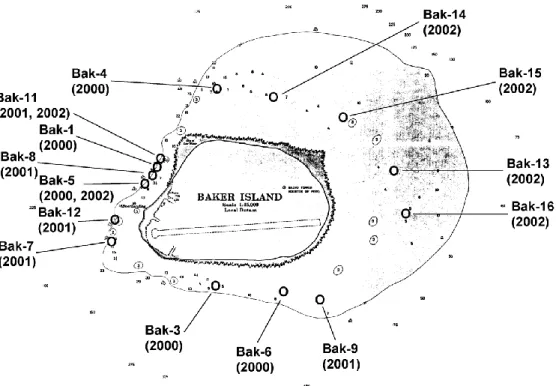
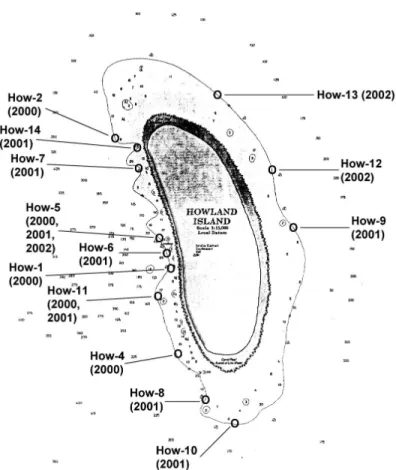
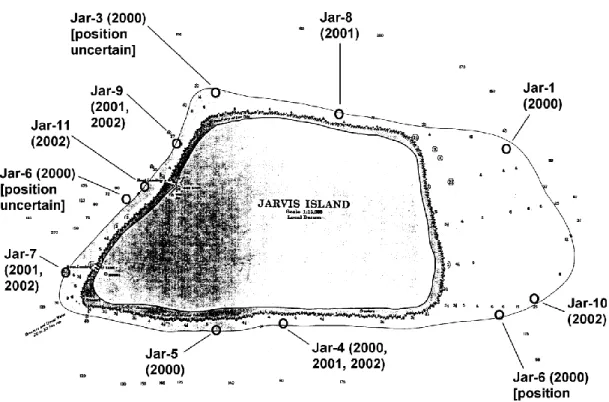
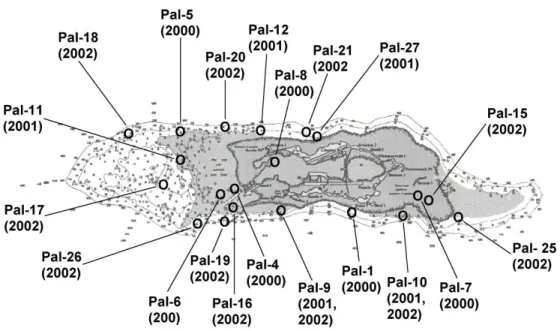
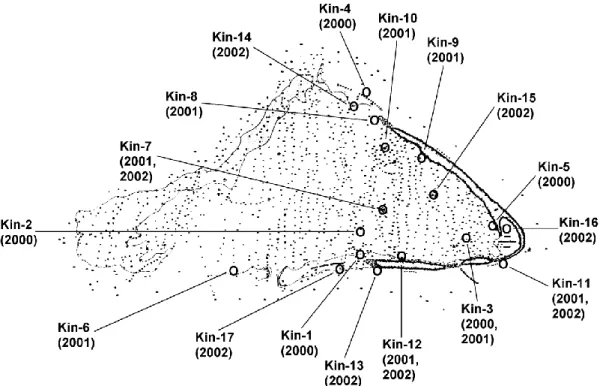
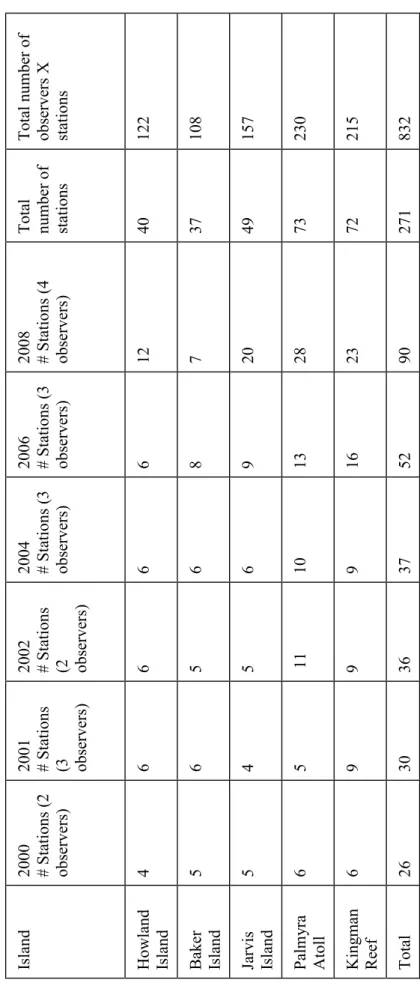
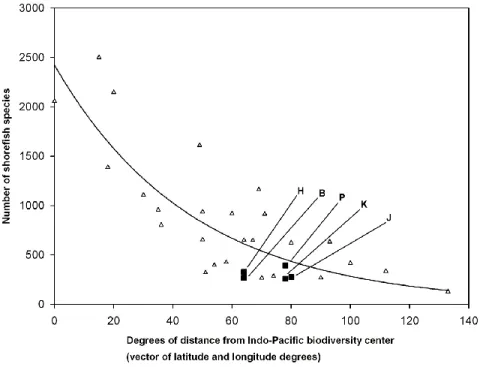
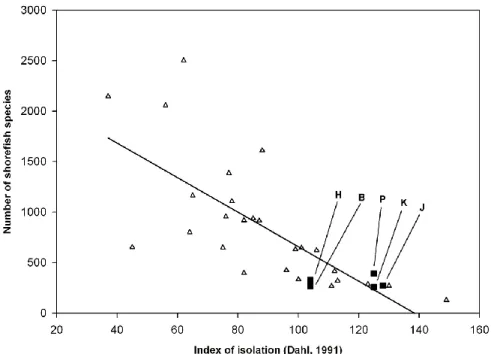
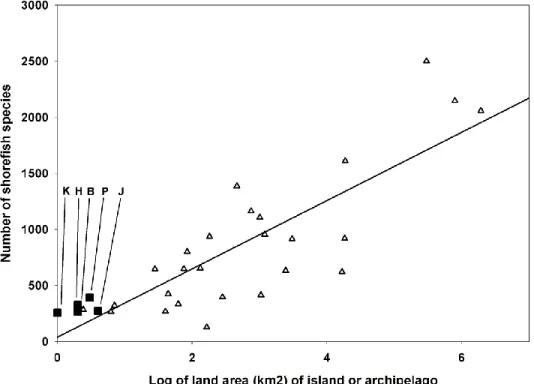
![Figure 10. The relationship between the number of shorefish species recorded at oceanic Pacific islands and archipelagos, and the the island-age model [log(island area) + island age + (island age)2] of Whittaker et al](https://thumb-ap.123doks.com/thumbv2/123dok/11180394.0/71.918.182.729.152.549/figure-relationship-shorefish-species-recorded-pacific-archipelagos-whittaker.webp)